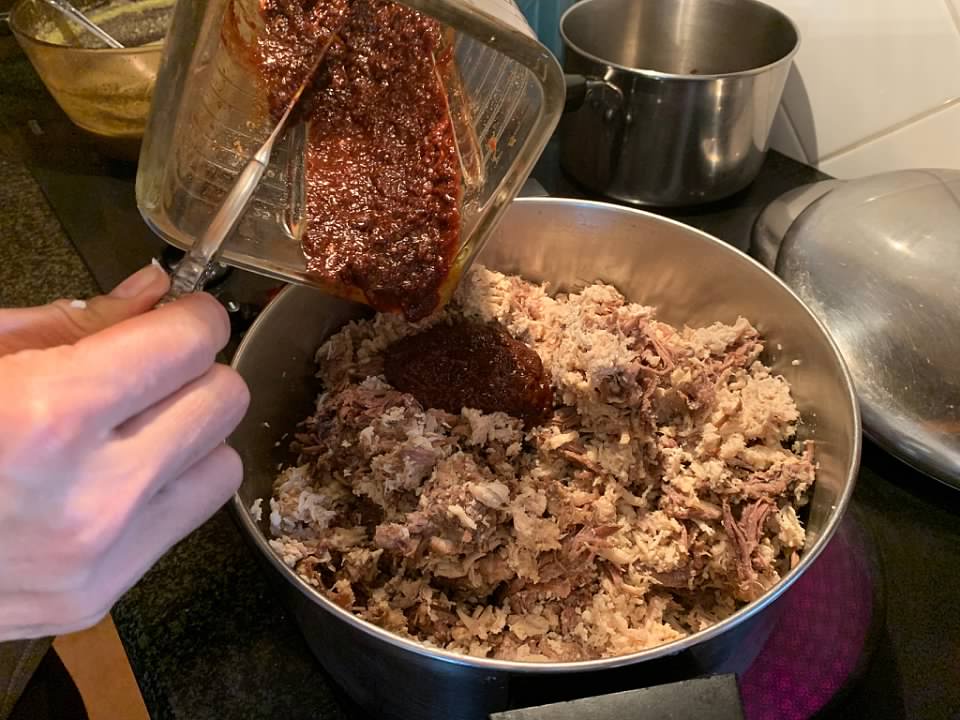During the Christmas holidays, it was a family tradition in Tricia's household growing up to make tamales. It was a family thing with all hands on deck. Everyone had a job to do. The kitchen was filled with energy as the Garcia family assembled to make tamales. Indeed a family assembly line was formed up in the kitchen. Not only a fun family event, but one that would yield an abundance of deliciousness that all would enjoy.
We've continued that. Tricia taught me the intricacies of tamale-making. I am far from knowing what I'm doing. In fact, I'm still a novice, but there's an old saying about an old dog and new tricks... It is New Year's and not Christmas, but we still made it happen. Let's make some tamales!
It all starts with masa. Tricia poured some organic corn masa in a big stainless steel bowl.
In the background, Tricia was cooking the meat for the tamales and made some broth and saved that to pour into the masa.
Once that was mixed in, salt, garlic, and chili powder were added and combined along with fats. Tricia used beef tallow, coconut oil, and butter. All this was stirred together. The aroma of spices filled the air.
It was time to get the corn husks ready.
The corn husks were taken from the bag and soaked in warm water for 30 minutes. This softens them up and makes them easy to work with.
Meanwhile, Tricia used dried whole peppers to make spices for the meat. The peppers are cut, seeds removed and boiled in water for 5 minutes to reconstitute.
The peppers are then blended in a blender with lots of garlic. Look at the beautiful color!
This pepper/spice mixture is poured into the meat along with black pepper and cumin. The meat is a 2.5 pound beef roast and a 5 pound chicken. It rendered 3.5 pounds of de-boned, cooked meat.

Stir it all in, taste it, and adjust spices.
Then it is time to start making the tamales! Using a spoon or a butter knife, we spread masa on the softened corn husks - about halfway up. This is a tricky task. You don't want it too thick, but not too thin, either.
The next person on the assembly line adds a tablespoon of meat to the center.
Then the tamale is rolled up and folded over. This process is repeated many, many times!
At the end of the evening, we had a big mess in the kitchen, but also 10 DOZEN tamales! 10 cups of dry masa produced 10 dozen tamales. These are stacked by the dozen and are now ready to be cooked.
Now we cook them by stacking them atop a steamer in a bucket with water in the bottom and steam them for about two hours. The tamales aren't sitting in the water. They are above it. As they steam, the kitchen fills with a wonderful aroma and everyone watches the clock until we can eat!
We covered the bucket (Rosie's old milking bucket!) with a lid with a weight on top. Tricia used a molcajete turned upside down as the weight because that's how her mom did it. A molcajete is a stone pestle and mortar used to grind fresh spices.
Now, you're not going to believe this, but I don't have photos of the finished product, because we were so busy eating, we forgot to take pictures. Ain't that a shame. We put tomato sauce or salsa or hot sauce on top and eat a bunch of them! It was New Year's Eve and Russ' birthday, so we shared a toast of some Martinelli's Sparkling Apple Cider.
Happy New Year's, Everyone. Oh, yeah, tamales freeze very nicely, so we have some put up in the freezer for future feasting!




